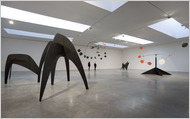 Artful Way to Expand a Museum
Artful Way to Expand a Museum To expand downtown or not to expand downtown, this is the nagging, seemingly unanswerable question facing the Whitney Museum of American Art. The museum won’t know the right answer for sure until it tries it; if it doesn’t, it will never know. But it is right in asserting that it must do something to remain viable in what has become a cutthroat competition for museum visitors in New York.
Robert McKeever/Gagosian Gallery
The Gagosian Gallery's recent exhibition of works produced by Alexander Calder from 1957 to 1970.
Its 1966 Marcel Breuer building has all the disadvantages of starchitecture and few if any of the rewards. Even in a country where museums are rarely designed with art in mind, it stands out as relentlessly unforgiving to works of all styles and periods. If the stone floor doesn’t kill, the oppressive overhead concrete structure almost undoubtedly will.
Unlike the Guggenheim, the Breuer building is not considered a must-see destination by tourists, regardless of what shows are on view. And Breuer’s Brutalist bunker is not getting better with age, or inspiring artists to come up with new, exciting uses for it as Wright’s spiral is. At the same time, the Whitney doesn’t have enough space to have a big chunk of its collection serve as the draw, which is the case at the Museum of Modern Art and the Metropolitan Museum of Art.
So a second site seems like a good idea. But is the lower West Side the way to go? The west end of the meatpacking district is already something of a zoo, like SoHo. Which is to say that tourists are probably as thick there as in any other part of our increasingly Disneyfied city. But are they shoppers or art lovers? And even if they love art, will they pay to see it, when so much is available for free in Chelsea’s many art galleries? Attendance at the Dia Center for the Arts, which used to be on West 22nd Street, dropped as the number of neighborhood galleries increased.
The Whitney doesn’t just need more gallery space, it also needs great or even just good gallery space. This commodity is in short supply in New York these days. The New Museum’s galleries are generally viewed as horribly proportioned and oppressive in their lack of windows. The Modern’s new building is, simply put, one of the great cultural tragedies of 21st-century New York.
The Whitney’s design for its downtown site is by Renzo Piano, whose track record for museums hasn’t been too great lately. His Broad building at the Los Angeles County Museum of Art is SoHo-Chelsea chic times three. His atrium at the Morgan Library and Museum, while beautiful as a space unto itself, is of the event variety; it has diminished, not improved, that museum’s gallery spaces and their layout. And then there is the Art Institute of Chicago, another event-oriented space where art is tucked away. It was definitely a relief to read in The New York Times on Monday, that Mr. Piano’s plans for angled walls at the Whitney’s proposed downtown building had to be eliminated to cut costs on his new design.
Not to diminish the financial and logistical risks of a venture like this, but New York’s recent museum debacles have taught us that space can justify the means. The success of an undertaking like this hinges not on the size but on the quality of the space, which is never thought about enough and never by the people who really know what they’re doing where museums are concerned. The idea that trustees have the final word on a museum’s design, considering all the atrocious buildings that have been erected in this country, is chilling. When will they ever learn to listen, and to people who have the right experience? They would get better spaces if they would loosen the reins.
A new downtown Whitney has to make art look good, make people feel good in it, inspire curators to do their best and give the place some kind of identity — a profile — the way Dia’s old building did. Which is to say that it doesn’t have to have tourist-attracting bells and whistles, as is the case with the Guggenheim (no disrespect intended). It just has to give people a breathtaking, vision-expanding experience of art. This is as much a matter of proportion, openness and light as square footage, as the old Dia proved repeatedly. Its spaces set a standard for display that seems to have been lost in Manhattan, and it was lost, again, because of trustee arrogance and administrative mismanagement that put too many of the Dia’s eggs in its Beacon, N.Y., basket.
Whom should the people in charge of museums listen to? Perhaps to those who have consistently made art look best because they are most directly dependent on it looking best: artists and dealers. A well-chosen committee of such people would probably be able to pare down and improve Mr. Piano’s design even more.
Here’s a shocking idea: hire Larry Gagosian as a consultant. This could be seen as a more cautious, less desperate version of the move by the Museum of Contemporary Art in Los Angeles in hiring the dealer Jeffrey Deitch as its new director: maybe it’s outside-the-box thinking Manhattan-style. Such an idea might occur to anyone who saw the Gagosian Gallery’s recent exhibition of a mere four sculptures by Alexander Calder, which unfortunately closed on Saturday. It was a heart-stopping, art-loving show that rewired and strengthened both the sense of Calder’s greatness and one’s own personal ability to see art. Affirmations like that keep people coming back.
 Artful Way to Expand a Museum
Artful Way to Expand a Museum